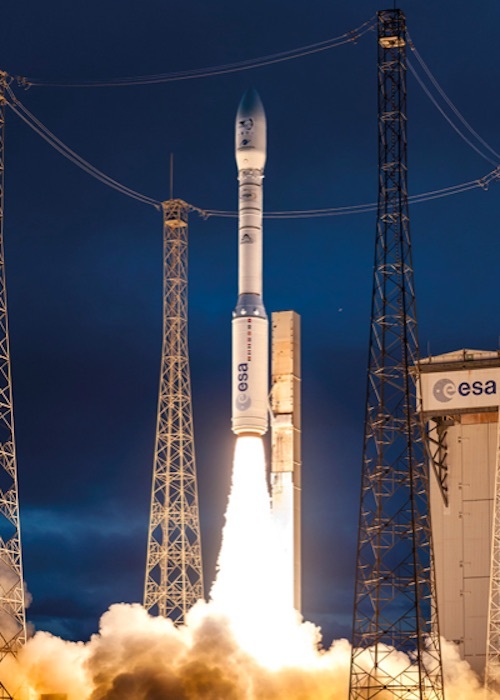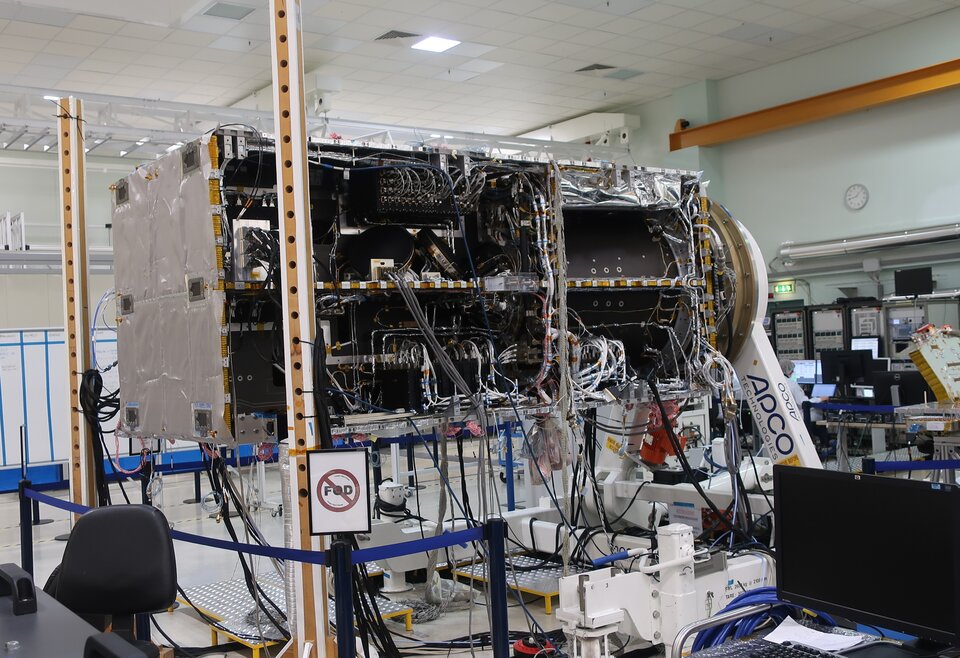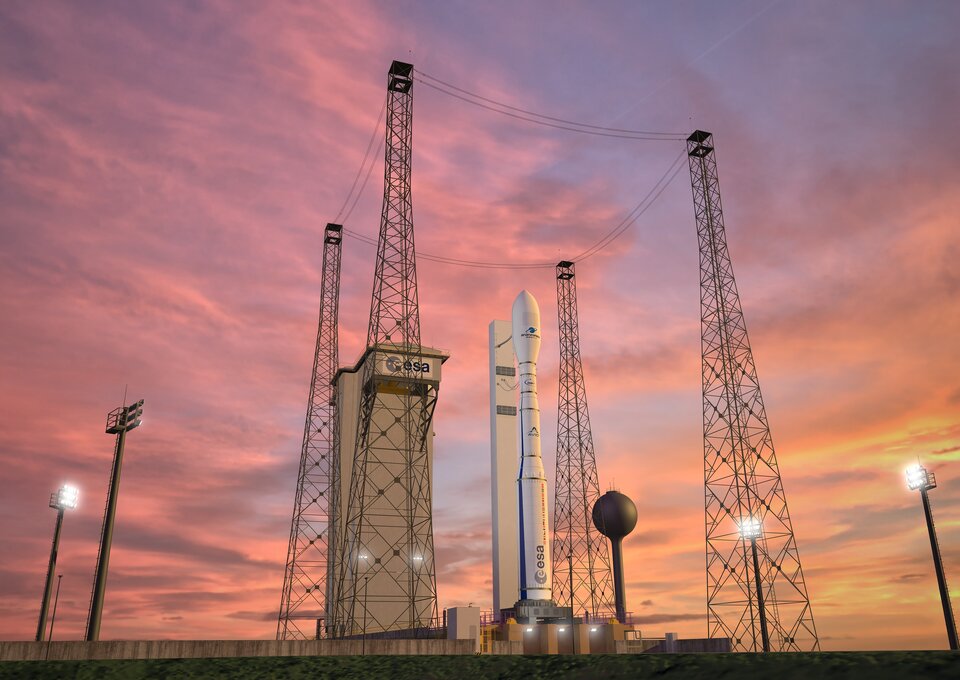9.04.2022
Arianespace wins new contract to launch Sentinel-1C observation satellite on board Vega-C
- The European Space Agency (ESA), on behalf of the European Commission, and Arianespace have signed a launch contract for the third radar satellite in the Sentinel-1 mission, Sentinel-1C.
– The launch is scheduled in the first half of 2023 from the Guiana Space Center, Europe’s Spaceport in French Guiana.
– Sentinel-1C is part of Copernicus, a joint European Union and European Space Agency (ESA) Earth Observation program.

Arianespace has been awarded a launch contract by the European Space Agency (ESA) on behalf of the European Commission, to launch Sentinel-1C in the first half of 2023 on Vega-C. The satellite, weighing around 2.3 metric tons, will be placed in a Sun-synchronous orbit with an altitude around 690 km.
“We are very proud of this new launch contract for the European Commission and the European Space Agency; it underlines our long-standing partnership for the success of Copernicus”, said Stéphane Israël, CEO of Arianespace. “For Arianespace, this contract is a sign of the confidence in the Vega-C system and a strong sign of the commitment of European institutions for an autonomous access to space”.
Before Sentinel-1C satellite, both Sentinel-1A and -1B were previously launched with Arianespace in 2014 and 2016. Sentinel-1C will round out the initial capacity offered by the two preceding satellites to offer a comprehensive response to the needs for environmental and security monitoring via spaceborne radar systems. Sentinel satellites are part of the Copernicus program designed to give Europe continuous, independent and reliable access to Earth observation data.
Copernicus, one of the flagships of the European Union Space Programme, presently includes eight Sentinel satellites: Sentinel-1A and -1B radar imaging satellites, Sentinel-2A and -2B optical imaging satellites, Sentinel-3A and -3B for ocean and atmosphere monitoring; Sentinel-5P enables monitoring the quality of air, while Sentinel-6 is monitoring sea levels. Other Sentinels are in preparation, such as Sentinel-4, Sentinel-5 and the CO2 monitoring mission, to name a few.
ESA’s new Vega-C launcher, built by Avio (Colleferro, Italy) as prime contractor, has been specifically upgraded to launch satellites of the class of Sentinel-1C and it is perfectly suited to serve the Earth Observation market because of its performance and versatility. With Vega-C and Ariane 6, Arianespace is able to offer the best possible solutions to orbit all kind of payloads for any range of applications.
Quelle: arianespace
+++
Ride into orbit secured for Sentinel-1C
A contract signed with Arianespace secures the launch for the third Copernicus Sentinel-1 satellite. Scheduled to lift off on ESA’s new Vega-C rocket from Europe’s Spaceport in French Guiana in the first half of 2023, Sentinel-1C will continue the critical task of delivering key radar imagery for a wide range of services, applications and science – all of which benefit society.
Carrying advanced radar technology to provide an all-weather, day-and-night supply of imagery of Earth’s surface, the ambitious Sentinel-1 mission has not only raised the bar for spaceborne radar, but also set the stage for Copernicus, the Earth observation component of the European Union’s space programme.
Copernicus has been the largest provider of Earth observation data in the world for some years now. The suite of Sentinel missions deliver complementary data and the range of services offered through Copernicus help address some of today’s toughest environmental challenges such as food security, rising sea levels, diminishing ice, natural disasters, and the overarching issue of the climate crisis.
In April 2014, Copernicus Sentinel-1A was the first satellite to be launched for this remarkable environmental programme.

With the mission comprising two identical satellites orbiting 180° apart to image the planet with a repeat frequency of six days, down to daily coverage at high latitudes, Sentinel-1B was launched in April 2016.
Sentinel-1A has already exceeded its design life of seven years – but is still going strong and expected to be in service for several years to come.
Sentinel-1B, on the other hand, is currently unavailable due to a technical anomaly, so it is important to get Sentinel-1C into orbit and operational as soon as possible.
The contract, which ESA signed today on behalf of the European Union by ESA’s Director of Earth Observation Programmes, Simonetta Cheli, ESA’s Director of Space Transportation, Daniel Neuenschwander, and CEO at Arianespace, Stéphane Israël, ensures Copernicus Sentinel-1C’s ride into space on a Vega-C rocket from French Guiana.
Simonetta Cheli said, “All of the Sentinel satellites ESA has developed and built for the European Union’s programme have been resounding successes and at the heart of this world-class environmental programme. The Sentinel-1 mission is key to delivering radar data to monitor sea ice, track icebergs and glaciers, subsidence, oil spills and much more. With many users relying on these data, we are extremely happy to secure the launch for Sentinel-1C on an ESA Vega-C rocket, furthering ESA’s autonomous access to space.”
Stéphane Israël added, “Once again, we are very proud of this new launch contract with the European Space Agency, in charge of the Copernicus space segment, which underlines our long-standing partnership. For Arianespace, this contract is a further sign of the renewed confidence in the Vega system and it’s reaffirmed its ability to meet users’ innovative needs.”

Vega-C is more powerful than its predecessor and is capable of a wide range of mission types. It is a single body rocket about 35 m high with a mass at liftoff of 210 tonnes. It is able to place about 2200 kg in a reference 700 km-polar orbit, meeting the needs of European institutions and industry.
The Vega-C rocket will place the Sentinel-1C satellite, which weighs around 2.3 tonnes, in a Sun-synchronous orbit at an altitude around 690 km.
Ramón Torres, ESA’s Sentinel-1 Project Manager, noted, “Sentinel-1C is currently undergoing the last stage of its test campaign. This includes environmental tests where the whole spacecraft is exposed to the mechanical and noise stresses that it will experience during launch, and the thermal, vacuum and radiation environment from where the satellite will be operating for the next years.
“Upon successful results, the full acceptance for flight is planned end of 2022”.
Quelle: ESA

